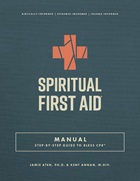How Faith Leaders Can Help Prevent Suicide in Their Communities

Did you know that suicide is a leading cause of death in the United States? In 2020, there were 45,979 deaths from suicide; that’s about one death every 11 minutes. For youth ages 10-14 and 25-34, suicide is the 2nd leading cause of death, and research shows that these rates are only increasing.
The good news is that in many cases, suicide is preventable. Mental and emotional wellness is possible, and there are new resources (like the 988 Lifeline) which connect youth and adults to the help they need.
Each of us can help by dispelling myths about suicide, encouraging protective factors that may prevent suicide, and learning how to identify and support people at risk for suicide. There are many tools and resources to inform and equip us.
Here are two myths I’d like to dispel:
The first is that there is a particular cause or reason for a suicide death. I’ve often heard the questions “why?”, “what happened?”, or “what was the cause behind the suicide death?” I think it’s important to know that suicide is rarely caused by a single circumstance or event. Instead, a range of factors—at the individual, relationship, community, and societal levels—can increase risk. The range of factors may include in individual’s history of depression or experience of bullying, other suicides occurring in a community, and/or stigma that prevents a person from seeking help.
The second myth I’d like to address is the belief that “talking about suicide might put the idea into a person’s head.” In fact, studies show that acknowledging and talking about suicide may reduce rather than increase suicidal ideation. This means we can’t be afraid to ask tough questions.
If you’re interacting with someone in emotional pain, ask them directly: “Are you thinking of suicide?” Other questions you can ask include, “How do you hurt?”, “How can I help?” and “How do you feel emotionally?”
To be informed and equipped to have these conversations, I encourage you and your community members to participate in one of the many available basic trainings. There are both in-person and virtual options, at low to no cost:
- Question, Persuade, Refer (QPR), a suicide prevention course;
- Mental Health First Aid, a mental health and suicide awareness course;
- Spiritual First Aid, a training which has been described previously here on “The Better Samaritan”;
- SoulShop Training, a training equipping leaders to serve those impacted by suicide;
- LivingWorks Faith, an online training to save lives affected by suicide.
- The Church Mental Health Summit, a one-day virtual event for church leaders and pastors
You can also check out federal guides, created to help you have conversations about mental health in faith and community settings, or learn the five action steps of the federally-supported #BEThe1To campaign.
These trainings touch on warning signs that may help to determine if a person is at risk for suicide. This is especially the case if the behavior is new, has increased, or seems related to a painful event, loss, or change. Warning signs may include a person talking about wanting to die or being a burden to others, acting anxious, and/or sleeping too much or too little.
You’ll also learn how to strengthen and encourage the factors that help protect against suicide risk, such as a strong sense of cultural identity and/or feeling connected to others.
What else can faith leaders and community members do? You can safeguard the people in your life and your community from the risk of suicide and support them by:
- Checking in. Research shows people who are having thoughts of suicide feel relief when someone asks after them in a caring way.
- Listening. While we believe in the power of prayer, additional support may be needed. Many times, listening allows us to decide what the next steps should be for the person suffering mentally or having suicidal ideations. Individuals are more likely to feel less depressed, less suicidal, less overwhelmed, and more hopeful after speaking to someone who listens without judgment.
- Keeping them safe. Studies indicate that when lethal means are made less available or less deadly, suicide rates by that method decline, and frequently suicide rates decline overall.
- Helping people connect. You can start with the 988 Suicide & Crisis Lifeline. By offering immediate counseling to everyone who needs it, local crisis centers provide invaluable support at critical times and connect individuals to local services. The 988 Lifeline (formerly known as the National Suicide Prevention Lifeline) provides free and confidential emotional support to people in suicidal crisis or emotional distress 24 hours a day, 7 days a week, through a national network of over 200 local crisis centers across the United States. Please share with your community that someone doesn’t have to be in crisis to call 988. The people who respond to calls at these centers are available for anyone who just needs to talk.
- Following up. Ongoing contact can be an important part of suicide prevention, especially for individuals who have been discharged from hospitals or care services. You can find out more about how these actions can save a life HERE.
Love will always be the anchor, and the drive, for us to do more for our congregations, family members, and communities. The last few years have not been easy for congregations or their leaders. Yet, it is love that brings out patience, kindness, longsuffering, gentleness, and empathy. And empathy goes beyond just feeling sorry for the individual; it says, “I can relate to you” and “I understand on a deeper level what you’re going through.”
Compassion, or empathy in action, takes love just one step further. Jesus Christ was that example for us; may we be that example for our communities of faith.
Rev. Dr. Que English serves as the Director of the Center for Faith-Based and Neighborhood Partnerships at the U.S. Department and Health and Human Services (HHS). In this role, she works closely with the White House Office of Faith-based and Neighborhood Partnerships, along with the CDC and offices like the Administration for Children and Families. The HHS Center’s core focus areas include addressing COVID-19, maternal health, mental health in youth, suicide prevention, and overdose prevention.
The Better Samaritan is a part of CT's
Blog Forum. Support the work of CT.
Subscribe and get one year free.
The views of the blogger do not necessarily reflect those of Christianity Today.






















